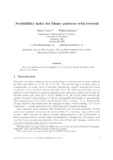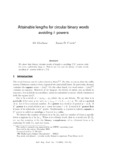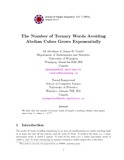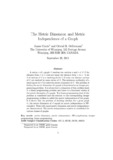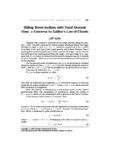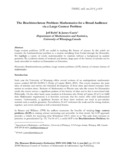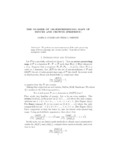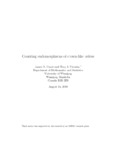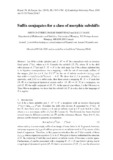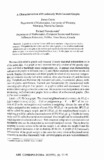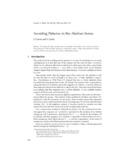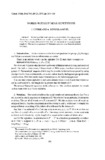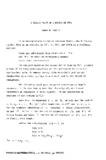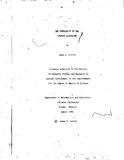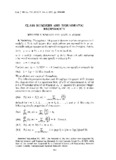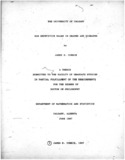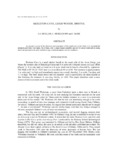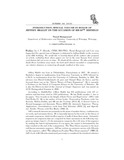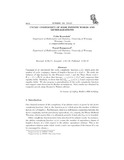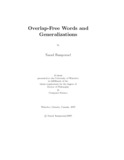Department of Mathematics and Statistics: Recent submissions
Now showing items 21-40 of 73
-
Avoidability index for binary patterns with reversal
(2017)For every pattern p over the alphabet {x,x^R,y,y^R}, we specify the least k such that p is k-avoidable. -
Attainable lengths for circular binary words avoiding k-powers
(The Belgian Mathematical Society, 2005)We show that binary circular words of length n avoiding 7/3+ powers exist for every sufficiently large n. This is not the case for binary circular words avoiding k+ powers with k < 7/3 -
The Number of Ternary Words Avoiding Abelian Cubes Grows Exponentially
(2004-06-19)We show that the number of ternary words of length n avoiding abelian cubes grows faster than r^n, where r = 2^{1/24} -
The metric dimension and metric independence of a graph
(The Charles Babbage Research Centre, 2001)A vertex x of a graph G resolves two vertices u and v of G if the distance from x to u does not equal the distance from x to v. A set S of vertices of G is a resolving set for G if every two distinct vertices of G are ... -
Sliding Down Inclines with Fixed Descent Time: a Converse to Galileo's Law of Chords
(Canadian Mathematical Society, 2008-12) -
The Brachistochrone Problem: Mathematics for a Broad Audience via a Large Context Problem
(Montana Council of Teachers of Mathematics & Information Age Publishing, 2008)Large context problems (LCP) are useful in teaching the history of science. In this article we consider the brachistochrone problem in a context stretching from Euclid through the Bernoullis. We highlight a variety of ... -
The number of order–preserving maps of fences and crowns
(Springer, 1991-06)We perform an exact enumeration of the order-preserving maps of fences (zig-zags) and crowns (cycles). From this we derive asymptotic results. -
Counting endomorphisms of crown-like orders
(Springer, 2002-12)The authors introduce the notion of crown-like orders and introduce powerful tools for counting the endomorphisms of orders of this type. -
Suffix conjugates for a class of morphic subshifts
(Cambridge University Press, 2015-09)Let A be a finite alphabet and f: A^* --> A^* be a morphism with an iterative fixed point f^\omega(\alpha), where \alpha{} is in A. Consider the subshift (X, T), where X is the shift orbit closure of f^\omega(\alpha) and ... -
A Characterization of Fractionally Well-Covered Graphs
(Ars Combinatoria, 1991)A graph is called well-covered if every maximal independent set has the same size. One generalization of independent sets in graphs is that of a fractional cover -- attach nonnegative weights to the vertices and require ... -
Avoiding Patterns in the Abelian Sense
(Canadian Mathematical Society, 2001-08)We classify all 3 letter patterns that are avoidable in the abelian sense. A short list of four letter patterns for which abelian avoidance is undecided is given. Using a generalization of Zimin words we deduce some ... -
Words without Near-Repetitions
(Canadian Mathematical Society, 1992-06-01)We find an infinite word w on four symbols with the following property: Two occurrences of any block in w must be separated by more than the length of the block. That is, in any subword of w of the form xyx, the length of ... -
A direct proof of a result of Thue
(Utilitas Mathematica, 1984) -
The Complexity of the Simplex Algorithm
(Carleton UniversityCarleton University, 1984-08)The thesis begins by giving background in linear programming and Simplex methods. Topics covered include the duality theorem, Lemke's algorithm, and the pathological programs of Klee-Minty. Because of the bad behaviour ... -
Class Numbers and Biquadratic Reciprocity
(Cambridge University Press, 1982) -
Non repetitive walks in graphs and digraphs
(The University of CalgaryUniversity of Calgary, 1987-06)A word $w$ over alphabet $\Sigma$ is {\em non-repetitive} if we cannot write $w=abbc$, $a,b,c\in\Sigma^*$, $b\ne\epsilon$. That is, no subword of $w$ appears twice in a row in $w$. In 1906, Axel Thue, the Norwegian number ... -
Skeleton Cave, Leigh Woods, Bristol
(University of Bristol Spelaeological Society, 2017)An account is given of the discovery and excavation of this small cave in the 1960s. It is recorded that archaeological finds were made, but of these, only a single human mandible can now be traced. Radiocarbon dating shows ... -
Cyclic Complexity of Some Infinite Words and Generalizations
(Integers, 2018-03)Cassaigne et al. introduced the cyclic complexity function c_x(n), which gives the number of cyclic conjugacy classes of length-n factors of a word x. We study the behavior of this function for the Fibonacci word f and the ... -
Overlap-Free Words and Generalizations
(University of WinnipegUniversity of Waterloo, 2007)The study of combinatorics on words dates back at least to the beginning of the 20th century and the work of Axel Thue. Thue was the first to give an example of an infinite word over a three letter alphabet that contains ...

